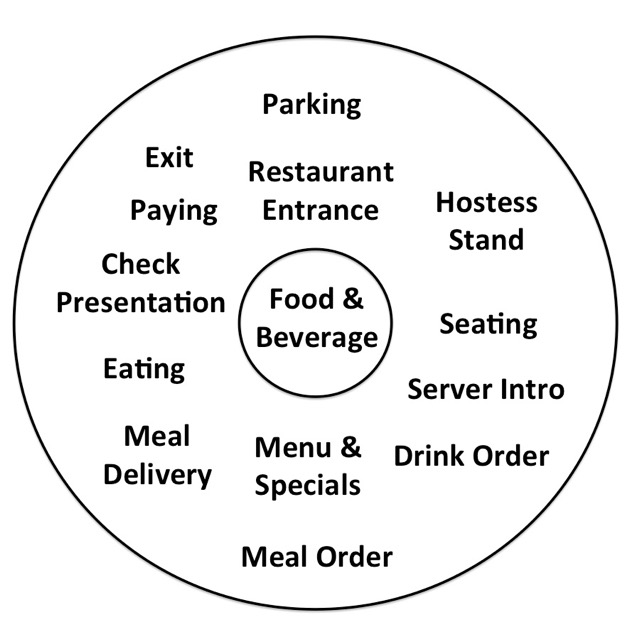Make Every Moment Matter
Posted on March 12, 2018 by Dennis Snow
Today’s customers have an almost unlimited number of choices for most products and services. Except in rare cases, products and services are becoming more and more commoditized every day. For most purchases, another option is either across the street or just a mouse click away. So, while it’s pretty hard to differentiate the product you offer, you CAN differentiate the experience you offer.
Here’s an exercise I do in many of my customer experience workshops. In the center of a piece of paper I have the workshop participants write the product they’re selling or the service they offer. Restaurant operators, for example, would write “food and beverage” in the center of the page. Attorneys at a law firm would write, “legal service.” Bank employees would write, “financial products” – you get the idea.
Surrounding what they wrote in the center of the paper, I ask the participants to write all of the processes a customer goes through in the purchasing of the product. They then draw a big circle around the whole thing. For a restaurant, the picture might look like this:

I make the point that what’s inside the BIG circle is what the customer is really buying. That’s the “true product.” That’s the customer’s experience with your organization. It’s hard to differentiate your offering by focusing entirely on the product in the center of the page. The improvement opportunities almost always lie in the processes surrounding that product.
Each of those processes offers an opportunity to impress the customer, disappoint the customer, or leave the customer feeling indifferent. They’re opportunities for a net gain, a net loss, or a neutral experience. With that in mind, the final part of the exercise is for the workshop participants to define exactly what would constitute a net gain to the customer’s experience, a net loss to the experience, or simply a neutral experience for each of those surrounding processes.
Using the restaurant example let’s take a look at three different scenarios regarding the hostess stand experience:
- Scenario 1 – You approach the stand, and the host or hostess greets you with a genuine smile and seems happy to see you. Maybe even welcomes you back if you’ve dined there before. You’re happy. Net gain
- Scenario 2 – You approach the stand, and the host or hostess is engrossed in the restaurant’s seating chart or chatting with a coworker, not acknowledging your presence until you signal that you’re there. You’re irritated. Net loss
- Scenario 3 – You approach the stand, and the host or hostess checks your name on the reservation list, grabs a couple of menus, and escorts you to your table. You’re indifferent. Neutral
The checkout process at a store provides another example:
- Scenario 1 – The employee ringing up the sale makes positive comments about your purchases, let’s you know that one of your items is on sale, and gives your small child a sticker. Net gain
- Scenario 2 – The employee rings up an item that's supposed to be on sale at full price. When you point out that the item is on sale, the employee seems skeptical and calls a manager to confirm the price. Net loss
- Scenario 3 – The employee simply rings up the sale, hands you the merchandise and sales receipt, and says, “Have a nice day.” Neutral
Even an unpleasant process like having your blood drawn during a doctor appointment can provide an example:
- Scenario 1 – The nurse gently talks with you throughout the process, distracting you from what’s happening, and gets the job done quickly. (I like it when the nurse also comments on how brave I am.) While it’s hard to think of ANY blood draw as a net gain, the manner in which the nurse completes the process in this scenario makes me give it a net gain rating.
- Scenario 2 – The nurse sticks you several times, appears frustrated about struggling to find a suitable vein, and announces that you’re a “hard stick” (true story). Net loss
- The nurse enters the examination room, says hello, draws your blood, and exits. Neutral
You can see in each of these examples that the employees in question had complete control over which of the three scenarios were offered – net gain, net loss, or neutral. The customer still ended up with the product or service they purchased, but in each case three very different experiences were delivered.
The exercise described here is a simple yet effective one for a team meeting. It’s a powerful way to get everyone thinking about the entire customer experience and how a change in approach impacts that experience. And when you move most or even ALL of the processes surrounding the product into net gain territory, you have truly created a differentiated experience that separates your organization from the rest of the pack.
Something to think about: When you look at the processes your customers must go through to buy your product or service, are each of those processes creating a net gain, net loss, or simply a neutral experience? Are you making every moment matter?